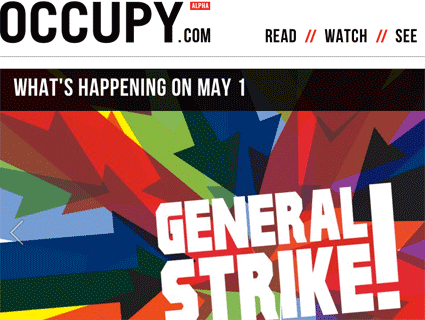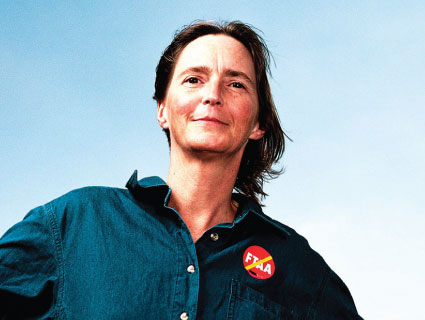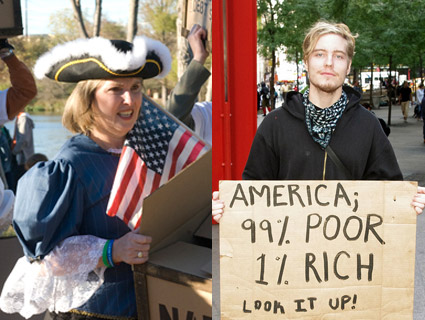
the99spring.com
If you’re one of the millions of people who get emails from MoveOn.org, then you’ve probably heard of the “99% Spring.” Far from another clickable internet petition, it is possibly the largest attempt ever to train people in nonviolent protest techniques. Some Occupy types have criticized the effort as a scheme by Democratic operatives to co-opt their movement. But the reality is probably the opposite: It seems that America’s best-known progressive fundraising organization is now taking its cues from Occupy Wall Street.
I didn’t know what to think of the 99% Spring until I stopped by a three-hour training session—one of more than 900 being held nationwide this week—at a Unitarian church in San Francisco. My presumption was that the 60 or so gray-haired attendees would be interested in supporting Democratic candidates—after all, the event was cosponsored by the Progressive Democrats of San Francisco—but many seemed just as disillusioned with electoral politics as the folks who took over New York City’s Zuccotti Park this past fall. “I believed Obama when he said he would change things and he didn’t, so I quit the Democratic Party,” said one middle-aged MoveOn member who asked that I not use her name. She went on to talk about about how “the deck is stacked” and “voting doesn’t work anymore.” She’d come to the training looking for a new way to get involved.
“It’s clear that the sorts of tactics we’ve engaged in in the past are no longer enough,” Justin Ruben, MoveOn’s Executive Director, wrote in an email to his staff last week, arguing that the growing corporate influence on policy-making has left the group little choice but to take to the streets. In a subsequent interview with Mother Jones, he added, “We know that whoever wins in November, they are still going to be listening more to the 1 percent than to the rest of us because our political system is completely broken. So we don’t have the luxury of not engaging in this kind of action.”
David King, a social worker who led the training I attended, told me he wanted to see MoveOn focus less on electoral politics and more on Occupy-style activism. “MoveOn needs some co-opting,” he said, “because they got co-opted a few years back.”
The session began with a slick video urging trainees to break into small groups and share their personal stories. Then came a condensed history of American social movements, followed by drills on nonviolent protest strategies. At no point did trainers suggest that their students get involved in specific political actions. “It was a really important piece for me that this wasn’t trying to funnel people into one campaign and wasn’t trying to funnel people into electoral politics,” said Sam Corbin, a veteran member of Occupy Wall Street’s Direct Action Working Group who agreed to star in the training video. “When they said we want to talk about ‘people power’ and making people understand and be comfortable with direct action, they meant it. I am really proud to have been part of it.”
Over the past six weeks, the 99% Spring has gone from an idea batted around on lefty email lists to a full-bore collaboration between dozens of activist groups, who, just like Occupy Wall Street, are loath to admit that any one of them is leading the effort. In addition to MoveOn, the coalition includes most of the nation’s largest labor unions, environmental groups like Greenpeace and Rainforest Action Network, and grittier Occupy allies like New Bottom Line and the Working Families Party. MoveOn contributed some its staff, access to its 7 million members, and use of its sophisticated web platform, where it will host online trainings next week.
Since fall, MoveOn has struggled to figure out how to ally itself with the Occupy movement. Though it donated tents and sleeping bags during Occupy’s Zuccotti Park phase, the movement’s radicals still tend to write off the group as an arm of the Democratic Party. At a December gathering of Occupy groups in DC, a tearful MoveOn council member from Connecticut complained that she’d been getting emails from people in her state “that we are not welcome at the Occupies there.”
While tensions remain, the 99% Spring might be a more natural way for MoveOn and similar groups to make friends with Occupy. Ruben says the coalition will eventually connect its trainees with Occupy-friendly actions such as protests at corporate shareholder meetings, defenses of foreclosed homes, and campaigns that encourage people to switch to credit unions over big banks. But it won’t recruit them to work on elections, despite what is likely to be a nail-biter presidential race.
Not that MoveOn’s participation in the effort will hurt its everyday electoral efforts. Ruben points to the role of Occupy in the GOP primaries, where none other than Newt Gingrich attacked Mitt Romney as a heartless capitalist. “The power of a relatively small group of people to shine a light on these issues that the whole political class would rather ignore just by virtue of their bravery and their moral clarity and willingness to put their bodies on the line—that’s always how justice is moved forward in America,” he says. “It’s on us to figure out how to support it in every way we can.”
Of course, MoveOn could have simply directed its members toward their local Occupy groups, which have been holding direct action trainings from the start (see “Meet Professor Occupy,” my profile of activist Lisa Fithian), but Ruben felt that the 99% Spring needed to move beyond Occupy Wall Street if it wanted to train 100,000 people in a couple of weeks time. Aiming large also allowed the coalition to attract people who might feel uncomfortable sucking tear gas fumes—like a 72-year-old retired car salesman I met at the San Francisco training, who showed up to see whether he should “spend my time volunteering for election stuff, or do this sort of thing.”
As the training session wrapped up, the facilitators urged anyone involved in organizing protests to speak up. One attendee referred the crowd to the websites of Occupy Oakland, Occupy San Francisco, and even Occupy Monsanto. May Day—a national day of action that Occupy has planned for May 1—was mentioned repeatedly. There were also rallies in support of postal workers and against Wells Fargo. Nobody said a word about gathering signatures or canvassing for candidates.
“It’s fine that we have MoveOn.org and we can press a button and sign a petition, but that isn’t going to get the job done,” an elderly woman in a red sweater told the crowd. “So we are here. And the real question is: What are we going to do when we leave here tonight? Are we going to stray out of our comfort zones and take some direct action together—or not?”













